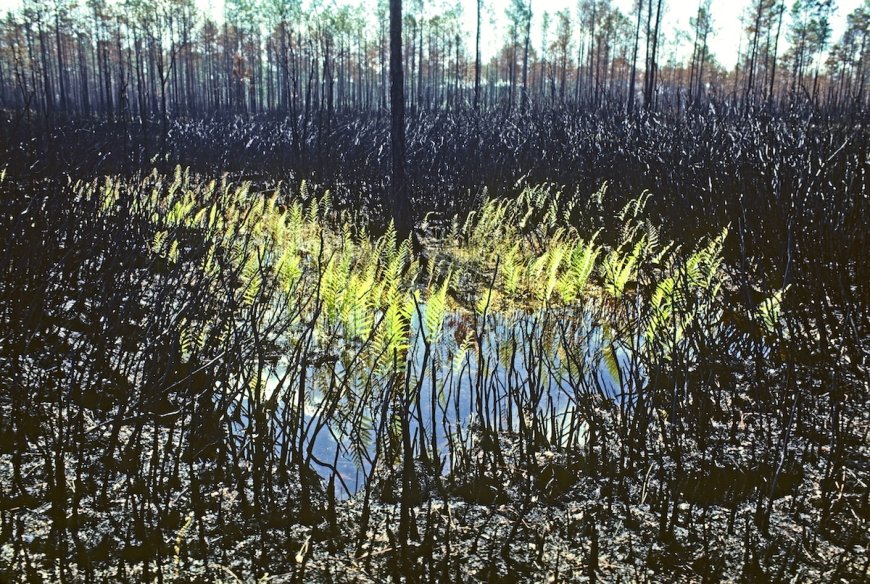Ancient Resilience of Ferns Helps Ecosystems Recover After Disasters
Scientists have discovered that, rather than competing with other organisms, the ancient resilience of ferns may facilitate and ease the path of other plants and animals in reestablishing themselves in damaged landscapes. The NASA-supported study looked at the recovery of biospheres following major disasters like wildfires using a “facilitative” framework — one where organisms’ actions […] The post Ancient Resilience of Ferns Helps Ecosystems Recover After Disasters appeared first on EcoWatch.

Scientists have discovered that, rather than competing with other organisms, the ancient resilience of ferns may facilitate and ease the path of other plants and animals in reestablishing themselves in damaged landscapes.
The NASA-supported study looked at the recovery of biospheres following major disasters like wildfires using a “facilitative” framework — one where organisms’ actions help each other — instead of the “competition-based” framework scientists have historically relied upon, a press release from NASA said.
“We propose that a competition-based view of ferns is outdated and in need of reexamination in light of growing research documenting the importance of positive interactions (i.e., facilitation) between ferns and other species,” the authors of the study wrote. “Here, we integrate fossil and modern perspectives on fern ecology to propose that ferns act as facilitators of community assemblage following biotic upheaval by stabilizing substrates, enhancing soil properties, and mediating competition. Our reframing of ferns as facilitators has broad implications for both community ecology and ecosystem recovery dynamics, because of ferns’ global distribution and habitat diversity.”
The study, “Ferns as facilitators of community recovery following biotic upheaval,” was published in the journal BioScience.
Ferns are found in a variety of environments, from woodlands to gardens and human households. Ferns neither flower nor seed — unlike many vascular plants — but reproduce via spores.
Ferns made their debut on Earth roughly 360 million years ago and were the most common of the planet’s vascular plants until flowering plants evolved.
Following major upheaval events, ferns are frequently one of first-seen plants to reestablish themselves. The reason for this has been said to be because the large amounts of spores ferns produce are widely distributed by the wind. This “competitive” success has been used as a foundation of ecological theories for how recolonization happens following disasters.
Recently, however, research has demonstrated that competition is not the only means of recovery. Facilitation between ferns and surrounding species has been found to play a critical role. The study’s authors believe positive interactions within ecosystems need to be reexamined, instead of defaulting to a competition-based framework.
“I love to imagine ecosystems through time and play a game in my head where I ask myself, ‘if I could stand here for 1 million years, would this fossilize?’” said lead author of the study Lauren Azevedo Schmidt, a researcher at in the Department of Entomology and Nematology at University of California at Davis, in the press release. “Because of the mental time gymnastics I do, my research questions follow the same pathway. How do I create synergy between modern and paleo research?”
The research team proposed that, by enhancing soil properties, stabilizing the ground and mediating other organisms’ competition with each other, ferns act as ecosystem recovery facilitators.
“This repositions ferns as facilitators of ecological recovery within disturbed habitats. This has broad implications for understanding how a community recovers and the importance of positive interactions following disturbance events,” NASA said.
Ferns are part of some of the oldest plant lineages on Earth, having lived through extinction events and unimaginable climates. Because of this, they can provide crucial information about the fossil record and life on our planet before humans.
“The Cretaceous – Paleogene [K-Pg] extinction event reworked Earth’s biosphere, resulting in approximately 75% of species going extinct, with up to 90% of plants going extinct,” Azevedo Schmidt said in the press release. “This magnitude of devastation is something humans (luckily) have never had to deal with, making it hard to even think about. But it is something we must consider when tackling research/issues surrounding exobiology.”
Ferns’ longevity is of interest to exobiology and astrobiology in exploring the impact of environmental factors on large-scale evolution through mass radiation and extinction events. It can help researchers grasp the possibilities surrounding the origin, distribution and evolution of life in other parts of the universe.
“In addition to their relevance to astrobiology, the resilience of ferns and their ability to help heal a damaged environment could also make them important partners for future human missions in space,” the press release said. “NASA’s Space Biology program has supported experiments to study how plants adapt to space with the expectation that knowledge gained can lead to ways by which crops can be cultivated for fresh food. Lessons learned from studying resilient plants, such as ferns, could guide efforts to make crops adapt better to harsh space conditions so they can serve as a reliable food source as humans explore destinations beyond our planet.”
Earlier studies have examined how plants could maintain clean air in enclosed spaces such as the International Space Station or on Mars or the Moon.
“Ferns were able to completely transform Earth’s biosphere following the devastation of the K-Pg [Cretaceous–Paleogene] extinction event. The environment experienced continental-scale fires, acid rain, and nuclear winter, but ferns were able to tolerate unbelievable stress and make their environment better,” Azevedo Schmidt said. “I think we can all learn something from the mighty ferns.”
The post Ancient Resilience of Ferns Helps Ecosystems Recover After Disasters appeared first on EcoWatch.
What's Your Reaction?




































